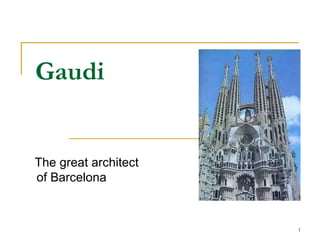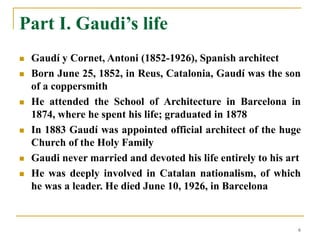Spanish Art Nouveau.ppt
- 1. 1 Gaudi The great architect of Barcelona
- 2. 2
- 3. 3 Outline ïŪ Introduction ïŪ Part I. Gaudiâs life ïŪ Part II. His work ïŪ Part III. Barcelona ïŪ Conclusion ïŪ References
- 4. 4 Introduction ïŪ The master Antoni GaudÃ, architect, artist and designer lived during the splendor of "Modernisme", the architectural and artistic movement in Catalonia, that had correspondence with "Art Nouveau" in France and "Jugendstil" in Germany ïŪ Antoni Gaudà executed most of his work in the city of Barcelona including the famous Sagrada Familia ïŪ Gaudà was an important participant in the Catalan Renaixensa, an artistic revival of the arts and crafts combined with a political revival in the form of fervent anti-Castilian "Catalanism."
- 5. 5
- 6. 6 Part I. Gaudiâs life ïŪ Gaudà y Cornet, Antoni (1852-1926), Spanish architect ïŪ Born June 25, 1852, in Reus, Catalonia, Gaudà was the son of a coppersmith ïŪ He attended the School of Architecture in Barcelona in 1874, where he spent his life; graduated in 1878 ïŪ In 1883 Gaudà was appointed official architect of the huge Church of the Holy Family ïŪ Gaudi never married and devoted his life entirely to his art ïŪ He was deeply involved in Catalan nationalism, of which he was a leader. He died June 10, 1926, in Barcelona
- 7. 7 Part II. His work ïŪ His style is often described as a blend of neo-Gothic and art nouveau, but it also has surrealist and cubist elements ïŪ The spires of El Templo Expiatorio de la Sagrada FamÃlia (Church of the Sacred Family), each more than 100 m tall, dominate the skyline of Barcelona, Spain ïŪ In 1891, nine years after construction started on the neo- Gothic cathedral, Gaudà took over as official architect and made the project a personal obsession ïŪ When Gaudà died in a trolley accident in 1926, the cathedral was left unfinished ïŪ Among GaudÃ's other celebrated works are two apartment buildings, the Casa BatllÃģ (1907) and the Casa MilÃĄ (1907)
- 8. 8
- 9. 9 Part III. Barcelona ïŪ Almost the entire professional activity of Gaudi occurred in Barcelona, the greater part of his work is there ïŪ The religious symbol of the Renaixensa in Barcelona was the church of the Holy Family, a project that was to occupy Gaudà throughout his entire career ïŪ Barcelona, city, northeastern Spain, capital of Barcelona Province and the autonomous region of Catalonia, a seaport on the Mediterranean Sea ïŪ Gaudà experimented with the Baroque in the Casa Calvet at Barcelona (1898-1904) ïŪ In his Villa Bell Esguard (1900-02) and the GÞell Park (1900-14), in Barcelona, and in the Colonia GÞell Church (1898-c. 1915), south of that city, he arrived at a type of structure that has come to be called equilibrated
- 10. 10
- 11. 11
- 12. 12
- 13. 13
- 14. 14
- 15. 15
- 16. 16
- 17. 17
- 18. 18
- 19. 19 La Sagrada Familia ïŪ Gaudi dedicated more than forty years of his life as an architect to the Neo-Gothic unfinished cathedral ïŪ He transformed the original design into a fantastical, soaring work that incorporates Gothic, Moorish, African, and purely imaginative influences into its structure ïŪ Despite controversy over whether the cathedral should remain in its uncompleted form as a monument to the architect, construction began again in 1979, closely following GaudÃâs original plan ïŪ The temple has a basilical floor-plan, with five naves and three transepts. The interior is 90m long and the transept 60m wide; the central nave measures 15m
- 20. 20
- 21. 21 Conclusion ïŪ Gaudi was totally dedicated to architecture; his personal and professional lives were one ïŪ Influenced by Violet-Le-Duc and Ruskin, he was one of the basic architects of Art Nouveau, where he is classified ïŪ After some years of criticism generated by the "Noucentisme" (artistic way opposed to Art Nouveau developed in Catalonia between 1910 and 1936), by the 1960s, he came to be revered by professionals and laymen alike for his boundless and tenacious imagination ïŪ Today the prestige of Gaudà is a fact accepted all around the world by specialists and people
- 22. 22






















